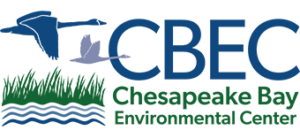Living Shoreline Restoration-Demonstration Area at the Chesapeake Bay Environmental Center
Created in 2002, the purpose of the living shoreline project was to restore habitat for beach nesting species and serve as a statewide demonstration project for alternative shoreline erosion control practices. This project uses recycled dredged material and concrete rubble. The project was designed as an alternative to increased use of hardening shorelines designed with bulkheads and rock structures.
The “living shoreline” project at CBEC restored 400 feet of shoreline and created 2 acres of tidal wetlands utilized primarily by diamondback terrapins, horseshoe crabs, herons, egrets and various shorebirds.
A 600 foot long “living breakwater” was installed offshore in conjunction with the shoreline project to provide oyster and fish habitat. Breakwater structures improve the success of shoreline projects by decreasing erosion from wave energy . This breakwater was constructed from recycled concrete rubble from the demolition of the Orioles Memorial Stadium and planted with half a million disease free oysters.
A living shoreline technique can be implemented by anyone who lives along the Chesapeake Bay that experiences tidal surges or erosion from wave energy. If there is already substrate in place you do not need a permit to plant native species of the Chesapeake Bay, but if substrate or machinery are required, check with your local state government offices to ensure you have the right permits before you continue.
Not only are living shorelines beneficial to the health of the Chesapeake bay, but it is a low cost appealing technique to secure soil substrate and beautify your property. An implemented living shoreline could cost you as low as three times less than investing in hard containment structures.
To further grasp the concept of a living shoreline project of your own,Visit Chesapeake Bay Environmental Centers Living Shoreline Display or
Check out the websites below:
Chesapeake Bay Trust https://cbtrust.org/watershed-assistance/
National Fish and Wildlife Foundation http://www.nfwf.org/chesapeake/Pages/applying-for-grants.aspx
Maryland Department of The Environment
http://mde.maryland.gov/programs/Permits/WaterManagementPermits/Pages/index.aspx
Maryland Department of Natural Resources http://dnr.maryland.gov/Wildlife/Pages/habitat/home.aspx
Environmental Protection Agency
https://www.epa.gov/wetlands/wetlands-restoration-definitions-and-distinctions
Partners
Maryland Department of Natural Resources (DNR)
National Oceanic & Atmospheric Administration (NOAA)
Army Corp of Engineers-Philadelphia
Chesapeake Bay Trust (CBT)
Gateways Network
Chesapeake Bay Foundation (CBF)
Maryland Conservation Corp (MCC)
CBEC Volunteers
National Fish& Wildlife Federation (NFWF)
Eastern Shore Resource Conservation and Development Council, lnc.
Oyster Recovery Partnership (ORP)
University of Maryland (UMCES) Horn Pt. Laboratory,
Keith Campbell Foundation

Leave a Reply
Want to join the discussion?Feel free to contribute!